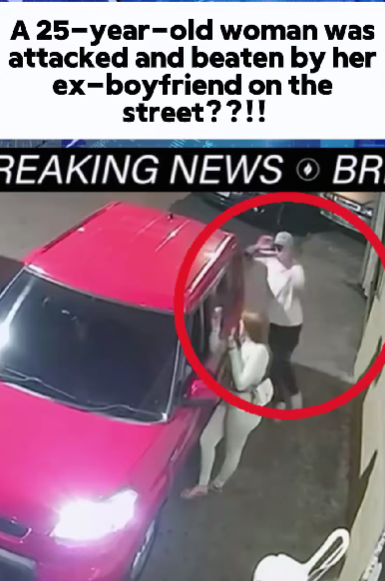A disturbing incident captured on security footage has spread quickly across social media, showing a 25-year-old woman being confronted and physically harmed by her ex-partner on a public street. Although the video is extremely difficult to watch, many viewers are using it as a wake-up call about the seriousness of domestic violence, how suddenly these situations can escalate, and how important it is for communities to stay alert and supportive when someone may be in danger.
The footage shows the woman standing beside a red vehicle when a man approaches her sharply. Within seconds, the situation turns frightening as he becomes aggressive. Although the clip does not reveal what led up to the moment, the behavior displayed has caused widespread outrage and concern. Many online have expressed that regardless of any disagreement, no one deserves to be treated with physical aggression, intimidation, or fear.
Experts who specialize in domestic-violence prevention explain that public incidents like this often reflect deeper, ongoing problems behind the scenes. Many victims experience control, emotional manipulation, threats, and fear long before a situation becomes physically violent. These patterns often continue even after a relationship has ended, making ex-partners especially vulnerable during moments of contact.
Viewers who saw the video have flooded the comments with messages of support for the woman, hoping she is safe and surrounded by people who can help her through the aftermath. Many survivors have also shared their own experiences, saying the video brought back painful memories but also reminded them of their strength and resilience. Their stories have encouraged others to speak out or reach out for help.
Advocates stress that domestic violence is not always visible. Some victims do not feel comfortable reporting incidents or telling friends and family, fearing judgment or retaliation. Others feel trapped emotionally or financially. Community awareness, they say, is one of the strongest tools in protecting people who may not feel empowered to protect themselves. When neighbors, friends, or even strangers recognize troubling behavior, intervention and support can make a life-saving difference.
Authorities in many regions emphasize that anyone who witnesses violence or a threatening situation should immediately contact emergency services rather than intervene directly, as these encounters can escalate quickly. They also recommend that victims document incidents, seek restraining measures when possible, and connect with support organizations trained to provide protection, legal guidance, and emotional assistance.
Online conversations surrounding the video have also become a space for education. Professionals are reminding viewers that violence is never the victim’s fault, and leaving an unsafe relationship can be extremely dangerous — often the most dangerous moment of all. The public is encouraged to listen without judgment, offer resources instead of advice, and help create environments where victims feel safe to ask for help.
As the story continues to spread, many people are expressing hope that the young woman receives the support she needs and that the incident leads to greater awareness in communities everywhere. While the footage is upsetting, it has sparked a larger, necessary discussion about safety, boundaries, and the importance of protecting those who may be suffering in silence.
If you or someone you know is experiencing domestic violence, local hotlines, shelters, and national support organizations are available to offer confidential help. No one should face threats or harm alone — and no one should ever feel unsafe simply walking down the street.
